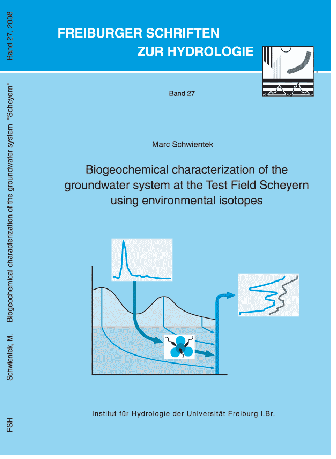|

Freiburger Schriften zur Hydrologie
 |
[ << Band/volume 26 ] [
Freiburger Schriften zur Hydrologie ] [
>> Band/volume 28 ]

Band/volume 27: Schwientek M. (2008):
Biogeochemical characterization of the groundwater system at the Test Field Scheyern using environmental isotope
 For a sustainable management of groundwater as important resource of fresh water it is essential to understand processes attenuating contaminants as well as the limiting factors. Nitrate, the most widespread agrochemical pollutant, may be readily degraded if organic energy sources are present. However, it is still not well understood if nitrate can be efficiently eliminated in aquifers depleted in organic substances and which role pyrite plays related to denitrification. To elucidate relevant processes, groundwater was sampled from an unconfined porous aquifer in southern Germany, using multilevel wells to 30 m depth with a vertical resolution of 1 m. The water samples were analyzed for tritium and chlorofluorocarbon contents and for physico-chemical parameters. Moreover, the isotopic compositions of groundwater nitrate (δ15N, δ18O) and sulfate (δ34S, δ18O) were determined. Field sampling was completed by a drilling to 30 m depth. The drill core sediment was sampled and analyzed geochemically and for the isotopic composition of sulfur compounds. For a sustainable management of groundwater as important resource of fresh water it is essential to understand processes attenuating contaminants as well as the limiting factors. Nitrate, the most widespread agrochemical pollutant, may be readily degraded if organic energy sources are present. However, it is still not well understood if nitrate can be efficiently eliminated in aquifers depleted in organic substances and which role pyrite plays related to denitrification. To elucidate relevant processes, groundwater was sampled from an unconfined porous aquifer in southern Germany, using multilevel wells to 30 m depth with a vertical resolution of 1 m. The water samples were analyzed for tritium and chlorofluorocarbon contents and for physico-chemical parameters. Moreover, the isotopic compositions of groundwater nitrate (δ15N, δ18O) and sulfate (δ34S, δ18O) were determined. Field sampling was completed by a drilling to 30 m depth. The drill core sediment was sampled and analyzed geochemically and for the isotopic composition of sulfur compounds.
Using the tritium concentrations combined with a lumped parameter approach, a depth profile of mean transit times of groundwater was modelled. The profile was characterized by two local maxima, each of ca. 100 years. Particle tracking analyses performed on the streamlines between the recharge zones and different sampling depths suggested that the observed transit time profile is mainly governed by the travel distance through the unsaturated zone at the point of recharge. The application of the chlorofluorocarbon data for the lumped parameter modelling yielded lower transit times than the modelling with tritium. This was explained by the faster transport of the chlorofluorocarbons through the unsaturated zone, showing that the impact of variable travel distances through the unsaturated zone may overweigh the effect of local heterogeneities on the distribution of transit times.
Chemical parameters and stable isotopes demonstrated that the oxic part of the aquifer with mean water transit times of approximately 60 yr is characterized by nitrate concentrations of around 15 mg/l and δ15N values of nitrate similar to those typical for nitrification. In contrast, in the anoxic part with mean water transit times of up to 100 yr, low nitrate concentrations accompanied by elevated δ15N values were observed. Furthermore, isotope data of groundwater sulfate and sulfur compounds in the aquifer sediment showed clearly that pyrite oxidation is the dominant source of sulfate in the aquifer. The trend of increasing δ15N values and decreasing nitrate concentrations was in concert with depleted δ34S values of groundwater sulfate similar to δ34S values of pyrite, FeS2. This suggested that denitrification coupled to pyrite oxidation is a dominating biogeochemical process in the aquifer. Additional microbiological experiments in the laboratory with sediment from the drill core indicated that denitrification is driven by ferrous iron. The resulting ferric iron, in turn, is an efficient oxidant for pyrite. Thus, an electron shuttle by iron cycling is proposed to link pyrite oxidation with denitrification.
Factors regulating such biogeochemical processes in the aquifer are the mean transit time of water, being decisive for the redox conditions, and the locally varying content of silt and clay in the sediment, providing the energy sources for microbial metabolism.
[ deutsche Zusammenfassung ]
|

